
The Ringtheater was a popular theater in Vienna, Austria. In 1881, it was destroyed in the Ringtheater fire that killed 384 people. The site now houses the federal headquarters of police for Vienna.

The Ringtheater was a popular theater in Vienna, Austria. In 1881, it was destroyed in the Ringtheater fire that killed 384 people. The site now houses the federal headquarters of police for Vienna.

The Ringtheater was built between 1872 and 1874 by Heinrich von Förster, following plans by Emil Ritter. It opened on January 17, 1874, under the direction of Albin Swoboda, Sr. as an 'Opéra Comique', antithetical to the "seriousness" of the Vienna State Opera, then called the Court Opera ('Hofoper'). Lighting was by gas. However, in September 1878, the focus was shifted to spoken plays, German and Italian opera and variety, and the name was changed to the "Ringtheater".

Given that the footprint of the theatre was small—and the theatre was intended to hold an audience of 1700—the architect was forced to build high, but with disastrous consequences. On December 8, 1881, a fire broke out due to a problem with the gas lighting system, shortly before a performance of Les contes d'Hoffmann , [1] and at least 384 people were killed. [2] The following year, a new law was passed, regarding the outfitting and safety provisions, including safety curtains, outward-opening doors, and fireproofing of the set.
An apartment building called the Sühnhaus was built on the site of the Ringtheater out of Emperor Franz Joseph's private funds; it was a private residence, which supported worthy causes. This was badly damaged by fire in 1945 and eventually collapsed in 1951. Between 1969 and 1974, an office block was erected on the site, in which the federal headquarters for police in Vienna and the general inspectorate of the federal security guards, and police commandos are housed. The fire is commemorated on a plaque on the police building. The Attic style statues, which had stood on the pilasters, are now in the Pötzleinsdorfer Schlosspark.

The Savoy Theatre is a West End theatre in the Strand in the City of Westminster, London, England. The theatre was designed by C. J. Phipps for Richard D'Oyly Carte and opened on 10 October 1881 on a site previously occupied by the Savoy Palace. Its intended purpose was to showcase the popular series of comic operas of Gilbert and Sullivan, which became known as the Savoy operas.

The Vienna State Opera is a historic opera house and opera company based in Vienna, Austria. The 1,709-seat Renaissance Revival venue was the first major building on the Vienna Ring Road. It was built from 1861 to 1869 following plans by August Sicard von Sicardsburg and Eduard van der Nüll, and designs by Josef Hlávka. The opera house was inaugurated as the "Vienna Court Opera" in the presence of Emperor Franz Joseph I and Empress Elisabeth of Austria. It became known by its current name after the establishment of the First Austrian Republic in 1921. The Vienna State Opera is the successor of the old Vienna Court Opera. The new site was chosen and the construction paid by Emperor Franz Joseph in 1861.

The Iroquois Theatre fire was a catastrophic building fire in Chicago, Illinois, that broke out on December 30, 1903 during a performance attended by 1,700 people. The fire caused 602 deaths and 250 non-fatal injuries. It ranks as the worst theater fire in the United States, surpassing the carnage of the Brooklyn Theatre fire of 1876, which claimed at least 278 lives.

The Vienna Ring Road is a 5.3 km circular grand boulevard that serves as a ring road around the historic Innere Stadt district of Vienna, Austria. The road is located on sites where medieval city fortifications once stood, including high walls and the broad open field ramparts (glacis), criss-crossed by paths that lay before them.

The Kroll Opera House in Berlin, Germany, was in the Tiergarten district on the western edge of the Königsplatz square, facing the Reichstag building. It was built in 1844 as an entertainment venue for the restaurant owner Joseph Kroll, and redeveloped as an opera house in 1851. It also served as the assembly hall of the Reichstag from 1933 to 1942. Severely damaged by the bombing of Berlin in World War II and the Battle of Berlin, it was demolished in 1951.
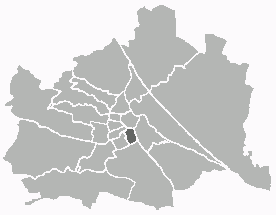
Wieden is the 4th municipal district of Vienna, Austria. It is near the centre of Vienna and was established as a district in 1850, but its borders were changed later. Wieden is a small region near the city centre. After World War II, Wieden was part of the Soviet sector of Vienna for 10 years.

The Salle Le Peletier or Lepeletier was the home of the Paris Opera from 1821 until the building was destroyed by fire in 1873. The theatre was designed and constructed by the architect François Debret on the site of the garden of the Hôtel de Choiseul on the rue Lepeletier. Due to the many changes in government and management during the theatre's existence, it had a number of different official names, the most important of which were: Théâtre de l'Académie Royale de Musique (1821–1848), Opéra-Théâtre de la Nation (1848–1850), Théâtre de l'Académie Nationale de Musique (1850–1852), Théâtre de l'Académie Impériale de Musique (1852–1854), Théâtre Impérial de l'Opéra (1854–1870), and Théâtre National de l'Opéra (1870–1873).

The history of Regina, Saskatchewan, the capital of the Canadian province of Saskatchewan. Prior to the province's establishment, Regina served as the territorial headquarters of the then-North-West Territories and district headquarters of the territorial district of Assiniboia.

Fellner & Helmer was an architecture studio founded in 1873 by Austrian architects Ferdinand Fellner and Hermann Helmer.
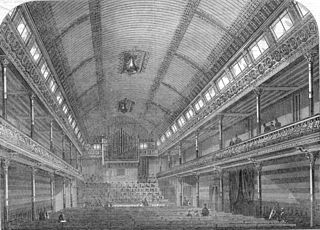
St. George's Hall was a theatre located in Langham Place, off Regent Street in the West End of London. It was built in 1867 and closed in 1966. The hall could accommodate between 800 and 900 persons, or up to 1,500 persons including the galleries. The architect was John Taylor of Whitehall.
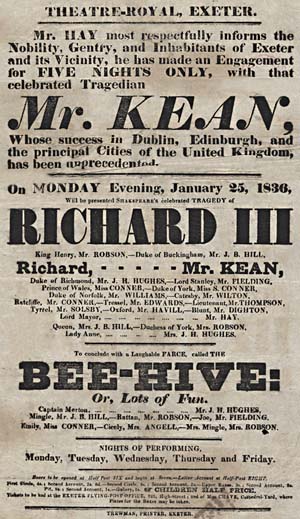
The Theatre Royal, Exeter was the name of several theatres situated in the city centre of Exeter, Devon, England in the United Kingdom.

Theater am Kärntnertor or Kärntnertortheater was a prestigious theatre in Vienna during the eighteenth and nineteenth centuries. Its official title was Kaiserliches und Königliches Hoftheater zu Wien.

The Stadsschouwburgof Amsterdam is the name of a theatre building at the Leidseplein in Amsterdam, Netherlands. The building is in the neo-Renaissance style dating back to 1894, and is the former home of the National Ballet and Opera.

The Carltheater was a theatre in Vienna. It was in the suburbs in Leopoldstadt at Praterstraße 31.

The Oldenburgisches Staatstheater is a German theater in the city of Oldenburg, Lower Saxony.
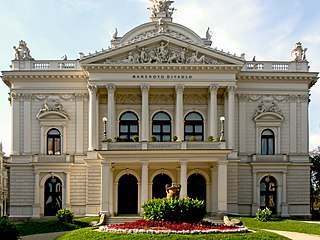
Mahen Theatre is a Czech theatre situated in the city of Brno. Mahen Theatre, built as German Deutsches Stadttheater in 1882, was one of the first public buildings in the world lit entirely by electric light. It was built in a combination of Neo-renaissance, Neo-baroque and Neoclassical architectural styles.
Albin August Heinrich Emil Swoboda was an Austrian operatic tenor, actor, and opera director of German birth. One of the most famous opera singers of the "Golden Age" of Viennese operetta, he was a leading tenor and dramatic stage actor at the Theater an der Wien from 1859–1878. He notably appeared in the world premieres of operettas by composers Jacques Offenbach, Johann Strauss II, and Franz von Suppé. He also appeared in musical comedies and plays in Vienna, and appeared in stage productions of all kinds as a guest artist in theatres in Germany, Hungary, Poland, and Russia. His son Albin Swoboda Jr. also had a successful career as an opera singer. In 1955 a street in the Hietzing district of Vienna was named after him.

The Ringtheater fire occurred on 8 December 1881, in the popular Viennese Ringtheater, named after the road it was located at, the Schottenring. Before the fire, the privately run theater, with capacity for an audience of about 1700, had been suffering from financial problems. Officially, 384 people perished in the fire, though there are higher estimates. For example, the Prussian-born author and encyclopedian Ludwig Julius Eisenberg (1858–1910) claims that up to one thousand could have been killed.
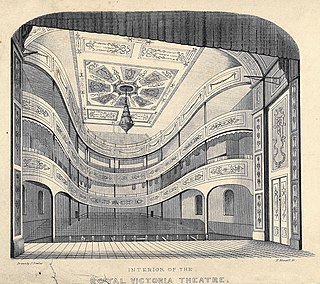
The Royal Victoria Theatre, often referred to as the Victoria Theatre or The Old Vic, was a theatre in Sydney, Australia, the first large theatre in the city. It opened in 1838; operas, plays, pantomimes and other events were held, and leading entertainers performed at the theatre. It was destroyed by fire in 1880.

The Landestheater Niederösterreich is a Schauspielhaus in the Lower Austrian provincial capital St. Pölten.
Most of the information in this article is taken from the German Wikipedia article.